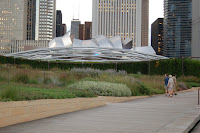That's it! No wonder I love blueberries: they're native plants! Truth be told, they are my favorite fruit, followed by peaches and strawberries. I'm one of those weird people who prefer fruit to chocolate! There's nothing better than fresh and local blueberries, peaches and strawberries. (Have you tried my peach salsa recipe?)
I planted two blueberry bushes in my garden last year, late in the summer. They were just beginning to produce berries when the drought and triple-digit heat set in, so needless to say I didn't enjoy more than a handful of fruit from them this year. They started to wilt too, so I've had to water them every day or two to keep them alive this summer. Maybe next year. (But I've read Heatstroke
So I've bought blueberries at the Williamsburg Farmers Market and I've noticed more and less expensive blueberries in the stores this year. I found some industry data that indicated blueberry production is growing. Terrific! My stepson and daughter-in-law in Chicago went blueberry picking in Michigan last year, came home with about 15 pounds of them. As true foodies, they commenced making blueberry preserves from various recipes. All of us back in Virginia loved their blueberry and other fruit preserves offered as Christmas presents. We told them that we're expecting more blueberry preserves this year!
I bought a big container of blueberries at Trader Joe's last week, and made a blueberry cobbler. By the weekend I'd had my fill of fresh blueberries on cereal and they were getting a little limp. It was time to make more baked goods. My husband has a favorite blueberry muffin recipe, which I share below. There are no directions because he's made them so many times that he neglected to record them. Basically, beat the eggs by hand for a bit and mix all of the ingredients except the blueberries until the ingredients are well blended. Add the blueberries last. Spoon the batter into 18 muffin cups, bake, and serve. Enjoy!
Blueberry Sugar Tops
1/2 cup and 2 Tbsp. oil
1 1/4 cups of sugar
2 eggs
2 cups flour
2 tsp. baking powder
1/2 tsp. salt
1/2 cup milk
2 cups blueberries (in 2 Tbsp. flour)
1 Tbsp. sugar
Bake in 375 degree oven for 25 to 30 minutes. Sprinkle tops with sugar.
P.S. Constant Craving? I'm taking some classes and might end up with a Speech-Language Pathology degree. In a recent course in Anatomy and Physiology, I used Constant Craving to illustrate great vocal chords. k.d. lang has a beautiful voice and she appreciates that to keep it that way she has to take care of those delicate vocal fold membranes.






















